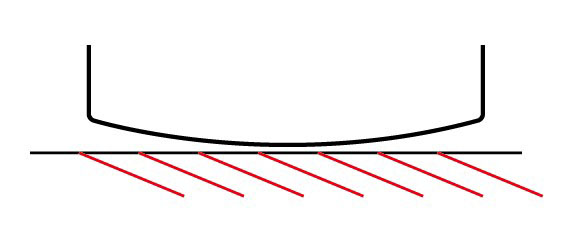For some Lotus Rock products, if the customer requests it, then a highly innovative design called Stable Concave can be added.
Generally, because Lotus Rock is produced with a strong construction, 2.0mm gauge, along with a thick ceramic coating on top of that, the Stable Concave design is not as necessary than for cookware utensils produced with a thinner thickness, such as 1.0 or 1.2mm. However, because carbon steel does have different thermal conductivity properties compared to pans which use aluminum, then it is possible that a Lotus Rock pan may, if the pan is continually over-heated for a long period of time, start to warp into a convex shape. If the pan is being used on a flat top cooking surface, such as induction, this could cause the pan to spin around when it is heated. Alternatively, long term over-heating might deform the pan’s bottom into more of a concave shape, which would cause the cooking oil in the pan to move to the side.
Therefore, in relation to the above problems, the benefits of Stable Concave are summarized as follows:
1) Stable bottom. Innovative design stops the pan spinning around, even after long heat exposure.
2) Oil displacement. The cooking oil always stays in the centre of the pan.
3) Strong base. The bottom will not become deformed over time. For long term use.
4) Heat control. The design of this base ensures that the pan does not become over-heated too easily (this is for use on Induction cooking tops).
General cookware base problems
A common problem experienced by cookware suppliers around the world is that over time the base of the cookware, often, under the pressure of intense heat from below, forms a highly indented convex shape which renders the cookware obsolete for use over flat surface cook tops.
Common Response
A solution used by a lot of cookware suppliers is to create a concave shape at the bottom of the pan to balance out the effect of the intense heat from below.
However, this curved shape cannot go above a certain height: if it does then the cooking oil does not concentrate in the centre of the pan. On the other hand if the height of the base of the pan is not set high enough then an undesirable convex shape will result.
Solution
The R&D team that created Lotus Rock have also developed an innovative design to counter this problem. As you can see below, the concave shape is placed in the middle of the base only, with the sides of the pan bottom arranged at a much flatter angle.
The smaller concave shape in the middle of the pan is still able, like the more general concave-shape design shown previously, to withstand the upward pressure emanating from the cook top. Conversely, the sides of the pan, which do not have the concave shape, respond to the increase in heat and do rise up (although this has the added benefit in that it keeps the oil in the middle of the pan). However once the cooking process is finished and the pan has cooled down, this area then lowers and returns to its original position.
Conclusion
Stable Concave deals with the twin problems mentioned above:
- A curved bottom.
The innovative design and strength of the base maintains a flat, stable bottom. This is good for long-term use.
2. Oil displacement.
The cooking oil stays in the centre of the pan throughout the cooking process. This means the food is cooked quickly and at a high quality.
An advantage for use on Induction cooking tops:
Temperature control. The magnetic coils inside the Induction cook top are not so close to the pans bottom. This means that the body of the cookware will not over-heat so easily.





